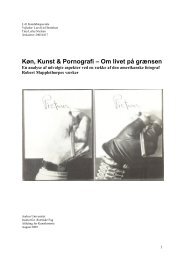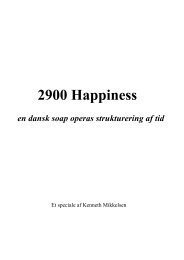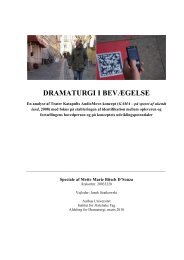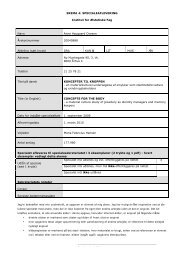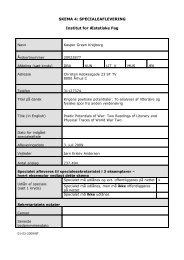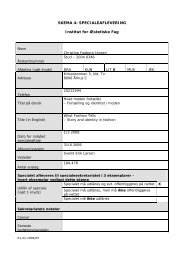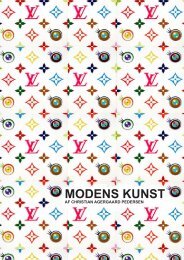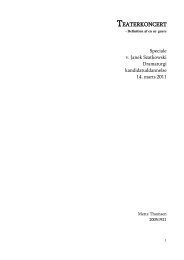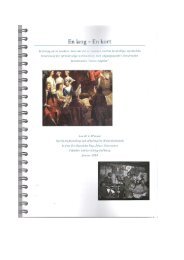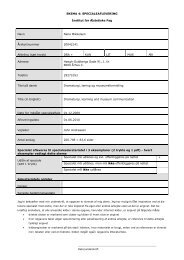Afdeling for Æstetik og Kultur — Tværæstetiske Studier - AU Library ...
Afdeling for Æstetik og Kultur — Tværæstetiske Studier - AU Library ...
Afdeling for Æstetik og Kultur — Tværæstetiske Studier - AU Library ...
Create successful ePaper yourself
Turn your PDF publications into a flip-book with our unique Google optimized e-Paper software.
Speciale af Helle Børsen Rosholm Vejleder Hans Jørgen Frederiksen<br />
Årskortnummer 20032411<br />
As an artist, Gauguin found that diverse works from distinctly different cultures could, on a<br />
<strong>for</strong>mal basis, be lumped t<strong>og</strong>ether as they had certain proporties in common: they did not<br />
imitate any observable reality, nor did they seem to create a three-dimensional reality;<br />
there<strong>for</strong>e, scale and proportion took a new meaning. The notion of the ”primitive” was eagerly<br />
discussed in France as elsewhere in the 19. century. Various discliplines studied and compared<br />
the ”primitive” in prehistory, in childhood and in tribal societies, as evidence <strong>for</strong> their<br />
arguments over man’s limitations, potentials and place in natural order, and the ”primitive”<br />
was often used as a positive or negative reflection of the Western, industrialized society.<br />
Many ideas regarding the ”primitive” were closely tied with the exoticism of the Romantic<br />
period. Exoticism was the ge<strong>og</strong>raphical counterpart of historicism’s emulation of the<br />
temporally distant; often, the two tended to flow into one another and it was these conceptions<br />
of the ”primitive” that inspired Gauguin to travel to <strong>for</strong> instance Brittany and Tahiti.<br />
By the art critic Albert Aurier, Gauguin was declared the leader of the Symbolist movement in<br />
painting in 1891.The Symbolist movement was a part of a broad anti-materialist and antirationalist<br />
trend in ideas and art, notions that Gauguin was discussing with passion with his<br />
fellow artists. They experimented with artistic innovations that in many ways were connected<br />
with cultural and philosophical trends of the last three decades of the 19. century. Inspired by<br />
various philosphical and religious theories they established a new relationship between <strong>for</strong>m<br />
and content, style and subject matter in the interest of giving personal experience and emotion<br />
meaning at a universal, human level. Many of these theories were adapted in parts and<br />
synthesized into a more modern context, and hybrids of convictions seemed to be the<br />
standard, as <strong>for</strong> example the theosophy, which contends to be a synthesis of all religions. Its<br />
principal doctrines were a pantheistic evolution and reincarnation, while the only morality it<br />
demanded was an adhesion to the brotherhood of man. Gauguin reflected over these notions in<br />
presenting himself <strong>for</strong> example in the role of en Initiate at the inn in Le Pouldu, much as he<br />
had adopted the guise of an outlaw or a Christ in other self-portraits.<br />
In many of Gauguin’s Symbolic paintings, reality was the starting point but more was<br />
expressed about it than was visible to the eye and Gauguin was inspired by the thought that<br />
colour and line in themselves could express ideas or feelings. One of the major qualities of<br />
these works of art was the ambiguity that Gauguin gained through his eclectic working<br />
methods.<br />
90





